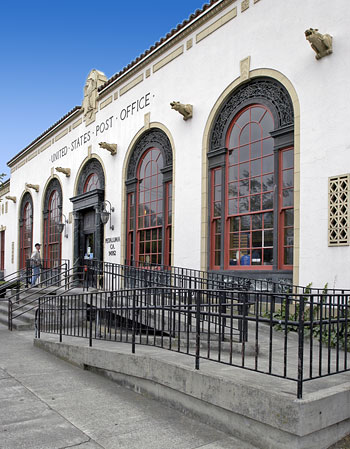National Register of Historic Places in Sonoma County
Petaluma Post Office
120 4th Street
Petaluma
Built 1933
The Petaluma Post Office, designed by the Office of the Supervising Architect, is an example of the transition from the classicism of the twenties to the Starved Classical style of the thirties in the design of federal buildings. The building is essentially Spanish Colonial Revival with gargoyle downspouts derived from Spanish Gothic archetypes.
The post office was authorized and funded by the 1926 Keyes-Elliot Act, and is an excellent example of the type of building constructed under this Act. The use of a central arcade flanked by projecting or recessed wings came to be a hallmark of designs of the late twenties and early thirties, and was one of the primary signifiers used in post office designs. The concept monumentalized the entrance without incurring significiant additional cost.
The Petaluma Main Post Office retains substantial integrity of location, design, setting, materials, workmanship, feeling, and association.
Adapted from the NRHP nomination dated 27 November 1984.

1869: United States Mint, Carson City
1888: Federal Government Building, Carson City
1893: United States Post Office and Courthouse, San Francisco
1910: United States Post Office and Courthouse, Eureka
1910: United States Post Office and Federal Building, Santa Rosa
1912: United States Post Office, Chico
1915: United States Post Office, Berkeley
1915: United States Post Office and Courthouse, Medford
1932: United States Post Office, Marysville
1933: United States Post Office and Courthouse, Las Vegas
1933: United States Post Office and Federal Building, Modesto
1933: United States Post Office, Petaluma
1941: United States Post Office, Tonopah

